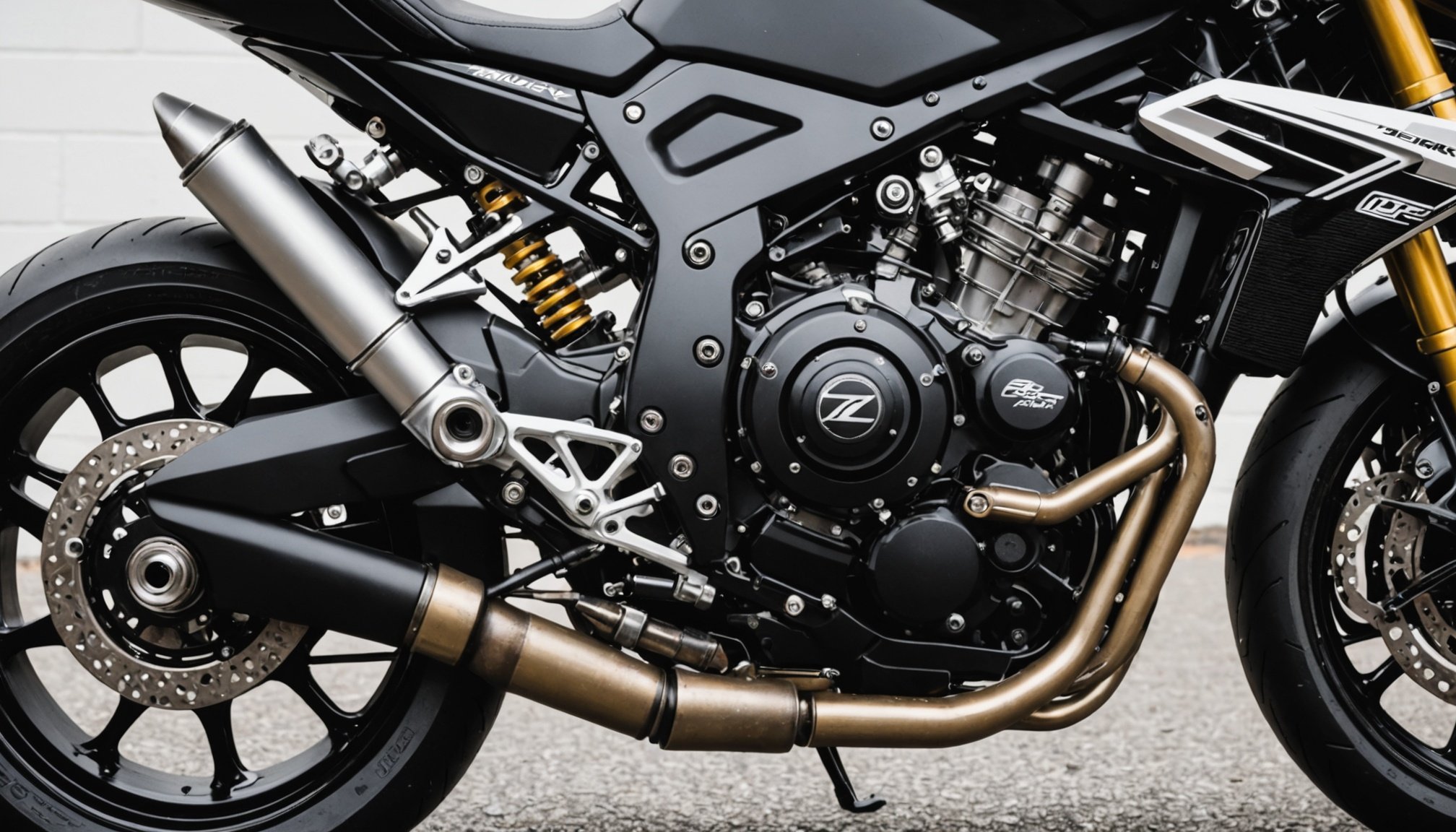Understanding Rearsets
Rearsets are crucial components for enhancing sport bike ergonomics, enabling riders to tailor their motorcycles for optimal comfort and control. Essentially, rearsets replace the stock foot pegs and controls, offering improved position options that cater to individual riding styles and physical dimensions. This adaptability is primarily beneficial in sportive environments where both precision and handling are paramount.
Purpose of Rearsets
The primary aim of rearsets is to allow riders to adjust foot position, which directly influences body posture on a sport bike. Altering the foot placement can reduce rider fatigue on long rides and provide better control during intense maneuvers.
Also to read : Unlock optimal fuel performance: a comprehensive guide to installing a power commander on your sport bike for uk road adventures
Importance of Adjustments
Comfort adjustments are particularly important for riders who experience discomfort or wish to optimize performance. Tailoring these settings can prevent cramps, enable easier reach to controls, and enhance stability when cornering. It allows for a more natural seating position, reducing the stress on knees and hips.
Types Available
There are several types of rearsets available, each designed to bring specific benefits. Fully adjustable rearsets allow comprehensive customization, while fixed types offer a simpler setup with predefined positions. Understanding these options can help riders select rearsets that enhance their riding experience, blending comfort with control seamlessly.
Also read : Essential sport bike glove selection for optimal grip in challenging uk wet weather conditions
Preparing for Installation
Before embarking on your rearset installation, ensure that you’re fully prepared with the essential tools required for the task. Common tools include wrenches, screwdrivers, Allen keys, and a torque wrench. Having these on hand will be indispensable for a smooth installation.
Next, conduct a thorough pre-installation inspection of your sport bike. This vital step confirms the compatibility of the rearsets with your bike model and checks for any underlying issues that may affect the installation. Look for any signs of wear or damage, particularly in the mounting areas where the rearsets will attach. This can save you from unexpected challenges during the process.
Safety precautions are crucial. Begin by securing your bike on a stable surface to prevent any accidental tip-overs. Disconnect the battery to avoid any electrical mishaps. Keeping a clean, organized workspace will prevent misplacing any components or tools. Wearing gloves can protect your hands, and eye protection is advisable if you’ll be using power tools.
With these preparations, you’re well-equipped to tackle the rearset installation confidently and efficiently. Taking these steps not only helps ensure a successful result but also enhances the longevity and performance of your motorcycle.
Step-by-Step Installation Process
Installing rearsets can enhance a motorcycle’s performance and compatibility with the rider’s preferences. Follow these steps to ensure a smooth installation.
Detaching Factory Footpegs
The first step in the rearset installation process is removing the factory footpegs. Begin by identifying the bolts securing the footpegs to understand their specific detachment method, as this can vary across different bike models. Use a compatible tool, typically an Allen wrench or socket set, to loosen and remove the bolts. Keep the hardware aside for future use or comparison.
Mounting the New Rearsets
Once the factory footpegs are removed, it’s time to correctly position and mount the new rearsets. Align them with the bike’s mounting points, ensuring the orientation matches the manufacturer’s specifications to guarantee compatibility. Gradually tighten the bolts using the appropriate torque settings, focusing on even pressure distribution to avoid misalignment.
Securing Components Properly
Finally, ensure all components are securely fastened. Double-check that each bolt and nut is tightened according to the manufacturer’s recommendations. It might be helpful to use a thread-locking agent on key points to prevent loosening over time. Re-assess the mounting techniques for a sturdy fit, minimizing potential vibrations and enhancing rider confidence.
Adjusting Rearsets for Comfort
Achieving the perfect ergonomic positioning with rearset adjustments can drastically improve your ride comfort. Key factors influencing adjustment settings include your preferred riding stance and individual body proportions. To tailor the rearsets to your needs, begin by noting your natural riding position. From there, make subtle changes to the rearset.
Optimal Riding Position Techniques
One of the primary techniques to find the optimal riding position involves trial and error. Begin by adjusting the rearsets incrementally, noting different settings that feel most natural as you ride. This process allows you to hone in on your specific preferred riding stance. Even small adjustments can significantly impact your bike’s handling and your comfort level.
Common Mistakes to Avoid
While adjusting, avoid major alterations to the rearsets that push the limits of your ergonomic positioning. Sudden or drastic changes can lead to discomfort or even unsafe riding conditions. Additionally, overlooking the interplay between your rearsets, handlebars, and seat can result in a misaligned riding stance. Always aim for a balanced adjustment across all contact points on your bike for a seamless riding experience. Remember, the goal is to enhance both comfort and control, ensuring you maintain a riding posture that feels just right.
Ensuring Compatibility with British Roads
British road conditions can present unique challenges such as potholes and winding roads, demanding specific adjustments for optimal performance and comfort. The effective handling of these issues is paramount for maintaining a smooth and safe ride.
To accommodate these conditions, suspension tuning becomes crucial. Properly adjusted suspension can help absorb the impacts of uneven surfaces. This involves refining suspension settings, such as damping and spring rate, to improve the vehicle’s ability to manage the dynamics of rough roads. Suspension expertise ensures safe and effective handling, crucial for navigating British terrains.
Furthermore, riders should consider adjusting their riding strategies. Slowing down on particularly rough surfaces and taking care during tight, winding turns enhances control and comfort. It’s essential to maintain a focused approach while navigating countryside lanes and urban backstreets.
The combination of adapting suspension settings and modifying riding strategies ensures a holistically improved experience. Not only does this lead to better control and safety, but also enriches the rider’s comfort. In essence, understanding and adjusting to the idiosyncrasies of British terrains is imperative for any motorist looking to optimize their journey.
Common Issues and Solutions
Rearsets are essential components of motorcycle customization, enhancing riding comfort and performance. However, they can present challenges during installation. Common rearset problems often involve misalignments, leading to discomfort or reduced control. Troubleshooting these issues requires careful attention to detail. First and foremost, ensure that the rearsets are precisely aligned with the motorcycle’s frame. This prevents undue strain on your legs and improves handling.
Comfort enhancements are vital for riders who experience discomfort from incorrect rearset positions. Adjusting the footpeg height can significantly influence rider posture and alleviate aches during long rides. Consider experimenting with different positions until the optimal setup is achieved.
Maintenance is key to avoiding rearset problems in the long term. Regularly inspect mounting bolts for tightness; loose bolts can immediately affect stability and safety. Apply lubricant to moving parts to maintain smooth operation and prevent wear. Embrace a routine of adjustment, ensuring that the setup remains consistent with your riding style and ergonomic needs.
For persistent issues, consult the manufacturer’s guide or seek professional advice. Remember, the precise alignment of rearsets not only enhances comfort but also contributes to safer, more enjoyable riding experiences. Always prioritize your comfort and safety when tackling rearset adjustments.
Visual Aids and Expert Insights
The importance of visual aids in the installation process cannot be overstated. These aids offer step-by-step guidance that helps prevent errors and ensures that the installation is done correctly. Whether it is diagrams, videos, or infographics, they simplify complex instructions and make the task approachable for both beginners and seasoned enthusiasts.
Recommended resources such as detailed installation guides are invaluable. They often include diagrams that depict each step clearly and concisely. Additionally, video tutorials are a fantastic resource for visual learners, providing real-time demonstrations of how to perform each step of the process. These visual aids make adjustments straightforward by showcasing the exact placement and alignment needed.
Expert advice adds another layer of assurance and expertise. Insights from professionals in motorcycle ergonomics and comfort can offer tailored recommendations based on common pitfalls or challenges. These experts understand the intricacies of motorcycle design and can provide solutions that enhance comfort and functionality. By integrating professional advice with visual aids, the installation process becomes not only easier but also more efficient and precise, ensuring an optimal setup every time.











